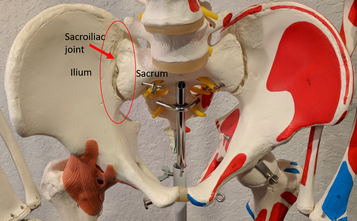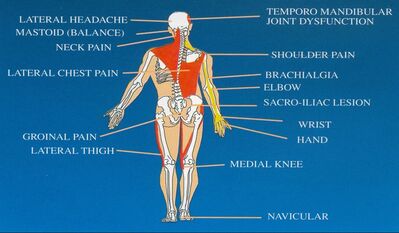 The sacroiliac joint can cause so many problems if it doesn't work right. The sacroiliac joint can cause so many problems if it doesn't work right. One thing I specialize in is the sacroiliac joint. The sacrum is at the base of your spine. Your ilium is your hips. They come together to form the sacroiliac joint. You can read older blog entries on the sacroiliac joint for a basic understanding. I recently attended another seminar which addressed the way the muscles of the body relate to this joint and how that relates to the ligaments that hold the joint together. Basically, the joint is held together by ligaments. In a sacroiliac joint injury, the ligaments are stretched. The joint becomes hyper-mobile. In an attempt to stabilize the joint, the body will activate a multitude of muscles and people will experience this as a multitude of symptoms. Some of them include:
 Image copyright Sacro Occipital Research Society International ® Image copyright Sacro Occipital Research Society International ® But there are so many muscles that attach to the pelvis that symptoms far away from the pelvis can actually be being caused by this sacroiliac joint problem. Some of these symptoms are:
Ultimately, the joint needs to be stabilized. It needs to be held together. This is contrary to much of the "standard of care" thinking in orthopedics, physical therapy and chiropractic, which focuses on mobilization of joints. Mobilizing the joint may give temporary relief, but ultimately it creates a perpetual problem with no end because the joint cannot heal.  SOT® wedge-shaped blocks are placed under the pelvis to correct the sacroiliac joint. SOT® wedge-shaped blocks are placed under the pelvis to correct the sacroiliac joint. Part of the way I decrease mobility in the joint is using wedged-shaped blocks that are placed under the pelvis. They help close the joint and compress the ligaments together. Sometimes this is enough to resolve the issue. Other times, patients need extra support. This is done by having the patient wear a trochanteric belt. Worn around the pelvis, it helps hold the joint together so the muscles don't have to. The muscles are then able to relax and the pain goes away. Exercises can also be given to strengthen some of the weak muscles that contributed to the injury occurring in the first place. Healing of the joint can take 4-6 weeks. Sometimes additional nutritional support can be given to help the joint heal. So many of my patients have sacroiliac joint problems and this is one of my specialties. If you would like to know more or set up an appointment, call the office at 727-509-3760 or send an email to [email protected]. You can also schedule appointments online.
24 Comments
 I have had tremendous success treating ADHD and ADD with Neurofeedback as a stand alone therapy. I did this before I was a chiropractor. Since becoming a chiropractor, I have started combining Neurofeedback and chiropractic care in some cases. With those cases, it seems to be that patients are responding faster to care. Why might this be? In the research I did on chiropractic effects on brain function using Sacro-Occipital Technic® (SOT®), we showed that there were changes in the frontal cortex in the brain. This is an area that relates to attention, impulsiveness and something called executive functioning. These are all things that people with ADHD can struggle with. Other research on chiropractic done by Haavik has also show that the frontal cortex of the brain is affected by chiropractic adjustments. By doing chiropractic at the same time as Neurofeedback, you are giving additional input into the brain to help it make the changes necessary to resolve the symptoms of ADHD. I like to do the chiropractic care and Neurofeedback on the same day, doing the chiropractic adjustment first and then the Neurofeedback. The idea is that you work more globally on the brain with chiropractic and then more specifically with Neurofeedback. I'm the only person in Pinellas County able to both evaluate and treat ADHD and ADD with this comprehensive approach combining my licenses as a Chiropractic Physician and a Licensed Psychotherapist. Do you or someone you know have ADHD or ADD? Are you looking for a long lasting solution without medication. Are you thinking a person might have ADHD or ADD but need to consult a professional to determine if they have this condition? If so, please give my office a call at 727-509-3760 or click above to book an appointment online.  Low back surgery is done to make you feel better. But according to a 2018 study, an estimated up to 46% of low back surgeries fail (1). The odds of a second surgery working are only 30% with a 15% chance of the third surgery working and a 5% chance of the 4th surgery working. Did you know they have an insurance code now for low back surgeries that don't work out? The insurance code is "M96.1 Postlaminectomy syndrome, not elsewhere classified." There are enough of them to make a code for it. As a Chiropractic Physician, I obviously advocate avoiding surgery if possible and will do everything I can in my power to help a person avoid surgery. This includes cases of low back pain and sciatica. But what if you already had surgery and it didn't work out? Is there still help? The answer is I've had great success working with people who had low back surgery that failed to provide relief. One method I use is Cox Technic flexion distraction. This is a gentle method of increasing mobility in the spine, opening up the disc space and taking pressure off of nerves. I also use Sacro-Occipital Technic®, which offers additional low-force options to help out a part of the body that has already been traumatized. If you want to find out if you are a candidate for treatment for failed low back surgery syndrome, call my office at 727-509-3760 or schedule online by clicking on the tab above. 1. Daniel, J., Osti, O. Failed back surgery syndrome: A review article. Asian Spine Journal. 2018. https://www.ncbi.nlm.nih.gov/pmc/articles/PMC5913031/ |
AuthorI'm a Chiropractic Physician, Psychotherapist and researcher. I'm interested in helping people live their lives to their full potential. That could be simply without pain. Or it could be without more complicated physical or mental health problems. Or it could be getting help in making changes in their life so that they can achieve their dreams. Archives
June 2023
Categories |
 RSS Feed
RSS Feed